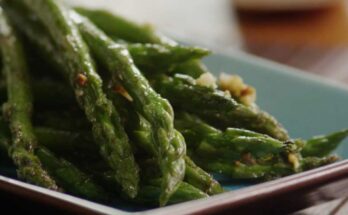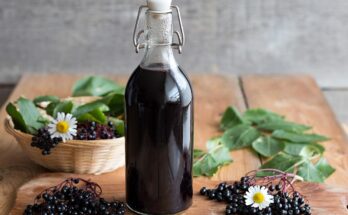Asian Salad Dressing Recipe: Asian salad dressings are the unsung heroes of many vibrant dishes. They bring together a beautiful blend of salty, sweet, tangy, and savory notes—all in one spoonful. Think of the zing from rice vinegar, the savory magic of soy sauce, the nutty hit of sesame oil, and a gentle kiss of sweetness from honey or maple syrup. That’s what makes an Asian dressing stand out. It doesn’t just coat your greens—it transforms them.
You’ll often find this dressing on crisp cabbage slaws, noodle salads, or even drizzled over grilled chicken or tofu. It’s versatile, easy to whip up in just a few minutes, and customizable depending on your taste preferences. Whether you’re meal-prepping for the week or need a quick fix to spice up a bland salad, this dressing will become your go-to. Let’s dive in.
Essential Ingredients in Asian Salad Dressings
Soy Sauce – The Umami Backbone
Soy sauce is the lifeblood of most Asian dressings. It’s rich, salty, and packed with umami, a flavor that brings everything together. Use low-sodium soy sauce if you’re watching your salt intake, or tamari if you’re going gluten-free. It’s essential for that deep, savory complexity you want in a good dressing. When paired with vinegar and oil, it creates a balanced foundation that complements both fresh vegetables and cooked proteins.
Rice Vinegar – The Tangy Twist
Rice vinegar is lighter and slightly sweeter than white vinegar, which makes it perfect for dressings. It provides just enough acidity to cut through the oil and balance out the saltiness from the soy sauce. For extra complexity, you can try seasoned rice vinegar, but keep in mind it’s already sweetened—so adjust your sweetener accordingly.
Sesame Oil – The Nutty Fragrance
A small splash of sesame oil goes a long way. Its toasty, nutty aroma is unmistakable and elevates any dish with a touch of depth. You’ll want to use toasted sesame oil, not the plain kind, as that’s where all the bold flavor lives. A few drops can instantly turn your salad into something restaurant-worthy.
Sweeteners – Balancing the Flavor
Every good Asian dressing needs a touch of sweetness. This helps to mellow out the acidity and balance the saltiness. Popular choices include:
- Honey
- Maple syrup
- Brown sugar
- Agave nectar
Choose your sweetener based on what you’re pairing the dressing with. For example, honey is perfect for chicken salads, while maple syrup goes well with grain-based bowls.
Optional Ingredients for Custom Flavor
Ginger and Garlic – Spicy Kicks
Freshly grated ginger and minced garlic take your dressing from basic to gourmet. Ginger brings a spicy, peppery note, while garlic adds that pungent depth we all love. They’re optional, but highly recommended if you’re aiming for a bold flavor profile.
Chili Flakes or Sriracha – For Heat Lovers
If you like a little heat, this is where you can play. Red pepper flakes, Sriracha, or even a touch of wasabi can add a spicy edge. Use sparingly and taste as you go.
Miso Paste – For Depth and Fermentation
Adding a spoonful of white or yellow miso paste infuses your dressing with an earthy, umami-rich flavor that’s hard to beat. It also adds a creamy texture, which makes it cling beautifully to salad greens and veggies.
Tools You’ll Need
You don’t need a fancy kitchen setup to make this dressing. Here’s what you’ll need:
- Small mixing bowl – for combining all your ingredients
- Whisk or fork – to blend the liquids thoroughly
- Measuring spoons – accuracy matters in balancing flavors
- Glass jar with a lid – for storing leftovers
A mason jar is especially handy because you can just shake everything up in it—no whisking needed.
Step-by-Step Guide to Making Asian Salad Dressing
Step 1 – Gather Your Ingredients
Here’s a simple base recipe:
- 3 tbsp soy sauce
- 2 tbsp rice vinegar
- 1 tbsp sesame oil
- 1 tbsp honey or maple syrup
- 1 tsp grated fresh ginger (optional)
- 1 small clove garlic, minced (optional)
- ½ tsp chili flakes (optional)
Step 2 – Mixing the Base
In your mixing bowl, combine the soy sauce, rice vinegar, and sesame oil. These three form the base of your dressing. Whisk until they are well blended. Add your sweetener next and whisk until fully dissolved.
Step 3 – Adjusting the Taste
Taste the dressing. Is it too salty? Add a bit more vinegar or sweetener. Too acidic? Add a touch more oil or honey. Want more heat? Sprinkle in those chili flakes.
Step 4 – Letting It Marinate
If you have time, let the dressing sit for 10-15 minutes. This allows the garlic and ginger to infuse the liquid, deepening the flavor. The longer it sits, the bolder the taste.
Step 5 – Storing for Later Use
Transfer the dressing to a glass jar and refrigerate. It will last for up to a week. Just give it a good shake before using, as natural separation is normal.
Pairing Suggestions
Best Salads to Use With Asian Dressing
Asian salad dressing pairs beautifully with a wide range of salads, thanks to its dynamic mix of salty, tangy, sweet, and nutty flavors. Here are some great combinations to try:
- Cabbage Slaw with Carrots and Scallions: This crunchy mix is a staple in Asian-inspired dishes and soaks up the dressing like a sponge.
- Mixed Greens with Mandarin Oranges and Almonds: A light and fruity salad becomes vibrant with a sesame soy dressing.
- Noodle Salads (Soba or Rice Noodles): Add edamame, cucumber, shredded carrots, and top with the dressing for a refreshing and filling option.
- Asian Chicken Salad: Grilled chicken, crispy wonton strips, napa cabbage, and sesame dressing make a perfect lunch combo.
Each of these salads brings out a different quality in the dressing. The best part? You can keep the base dressing the same and just tweak the ingredients to match your dish of the day.
Other Dishes That Benefit from It
Asian dressing isn’t just for salads. Here are a few other ways to use it:
- Marinade for Meat or Tofu: Let chicken, beef, or tofu soak in the dressing before grilling or baking.
- Drizzle Over Roasted Veggies: A splash can make broccoli, bell peppers, and even Brussels sprouts pop with flavor.
- Sauce for Grain Bowls: Pour it over quinoa or brown rice topped with sautéed veggies and a protein.
- Dipping Sauce for Dumplings or Spring Rolls: Mix with a little water to thin it out, and use as a dipping sauce.
Nutritional Benefits
Healthy Fats from Sesame Oil
One of the major nutritional perks of this dressing is its source of healthy fats—particularly from sesame oil. While sesame oil is high in fat, it’s primarily unsaturated fat, which helps lower bad cholesterol and supports heart health. Additionally, sesame oil contains antioxidants like sesamol and sesamin that may reduce inflammation and provide other health benefits.
Low-Calorie and High-Flavor Option
Asian salad dressings often use vinegar as a key ingredient, which keeps the calorie count low while boosting flavor. Unlike creamy dressings loaded with mayo or dairy, this oil-vinegar based dressing allows you to enjoy a flavorful salad without packing on extra calories.
Plus, if you make it at home, you can control everything that goes into it—no preservatives, artificial sweeteners, or unnecessary oils. You can go light on sweeteners or opt for a keto-friendly sugar alternative. Even small tweaks like using low-sodium soy sauce or avocado oil can enhance the nutrition profile.
Customization Tips
One of the best things about making your own Asian salad dressing is the ability to customize it to fit your dietary needs or preferences. Here are some easy ways to tailor it:
- Gluten-Free: Swap out regular soy sauce for tamari or coconut aminos. Both provide that umami depth without gluten.
- Vegan-Friendly: If you’re using honey, just replace it with maple syrup or agave nectar to keep it vegan.
- Keto-Friendly: Avoid sugar or honey and use erythritol, monk fruit sweetener, or stevia.
- Nut-Free: While sesame isn’t a tree nut, some people with nut allergies still avoid it. If that’s the case, substitute with avocado oil and add toasted sunflower seeds for that nutty aroma.
You can even play with flavors by adding citrus juice (like lime or orange), wasabi for spice, or finely chopped herbs like cilantro or Thai basil.
Mistakes to Avoid
Even a simple recipe like Asian salad dressing can go wrong. Here are some common mistakes to watch out for—and how to avoid them:
- Using Too Much Sesame Oil
This oil is potent. Overdoing it can overpower the other flavors. Stick to about a tablespoon unless you’re making a large batch. - Skipping the Sweetener
A touch of sweetness isn’t just about taste—it helps balance the acidity and salt. Even just a half teaspoon can make a difference. - Not Tasting as You Go
Everyone’s palate is different. Taste your dressing before calling it done. Adjust with a pinch of sugar, a dash of vinegar, or more oil as needed. - Overcomplicating the Recipe
Simplicity is key. Start with the basics and add complexity only if you’re confident in your palate. Too many ingredients can create a muddled flavor. - Storing Improperly
Store your dressing in a sealed glass container and refrigerate it. It will keep fresh for about a week. Shake before each use to remix the separated ingredients.
FAQs about Asian Salad Dressing Recipe
1. What is Asian salad dressing made of?
Asian salad dressing typically includes soy sauce, sesame oil, rice vinegar, garlic, ginger, and a touch of honey or brown sugar. Some versions may include chili flakes or lime juice for added zest.
2. Is Asian salad dressing healthy?
Yes, it can be! When made with wholesome ingredients like olive oil, low-sodium soy sauce, and natural sweeteners, it’s a heart-healthy option rich in flavor and low in artificial additives.
3. How long does homemade Asian salad dressing last?
Stored in an airtight container in the refrigerator, it can last up to one week. Be sure to shake or stir it well before each use as the ingredients may separate.
4. Can I make it gluten-free?
Absolutely. Just use gluten-free soy sauce (like tamari) or coconut aminos to make a gluten-free version of Asian salad dressing.
5. What salads go well with this dressing?
Asian salad dressing pairs beautifully with mixed greens, cabbage slaw, grilled chicken salad, noodle salads, or even as a drizzle over grilled veggies and tofu.
6. Can I use this as a marinade?
Yes! Asian salad dressing doubles as an excellent marinade for chicken, beef, seafood, or tofu. Let the protein sit in the marinade for at least 30 minutes for best results.
7. Can I make it spicy?
Of course. Add a dash of sriracha, crushed red pepper flakes, or a teaspoon of chili oil to kick up the heat.
8. Do I need a blender to make it?
No blender required. Simply whisk all the ingredients in a bowl or shake them together in a jar for quick and easy prep.
9. Can I store it at room temperature?
It’s best to refrigerate homemade Asian salad dressing due to the fresh ingredients like garlic and ginger, which can spoil if left out.
9. Can I store it at room temperature?
If you don’t have sesame oil, you can use olive oil or avocado oil, though it will slightly alter the flavor. Toasted sesame oil adds a unique nutty taste that’s hard to replace.
Conclusion
With the right balance of soy sauce, rice vinegar, sesame oil, and a hint of sweetness, you can elevate any dish from bland to brilliant. The best part? You can whip it up in minutes with ingredients you probably already have in your pantry.
So next time you’re eyeing a boring salad, skip the store-bought bottle and mix up your own batch of this flavorful magic. Your taste buds—and your health—will thank you.



